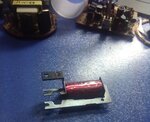J
Javid.zare.s
Guest

Hi
Im wondering if i can get a mechanical/electrical clocks coil and add a secondary wire on it and make a spark coil (low to high voltage converter)
How many turns does this coil have?
Will the wires melt down?
How they calculate the turns of secondary wiring?
And alot more questions
Im wondering if i can get a mechanical/electrical clocks coil and add a secondary wire on it and make a spark coil (low to high voltage converter)
How many turns does this coil have?
Will the wires melt down?
How they calculate the turns of secondary wiring?
And alot more questions



